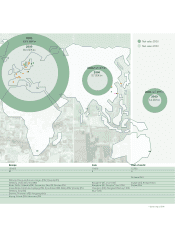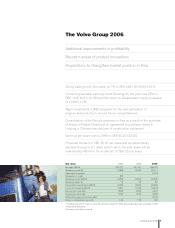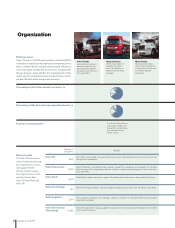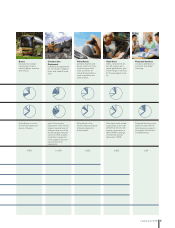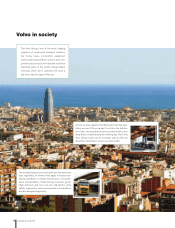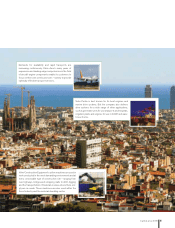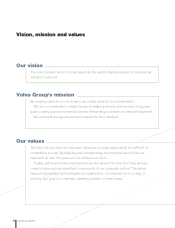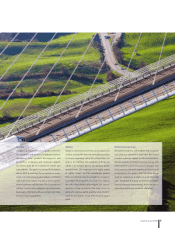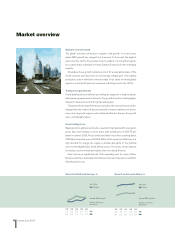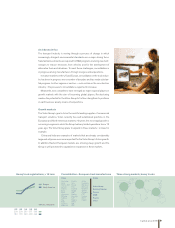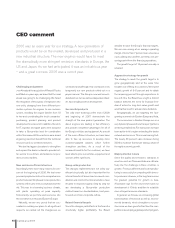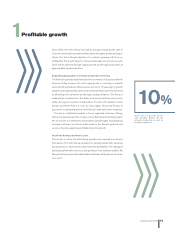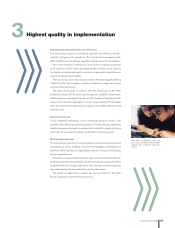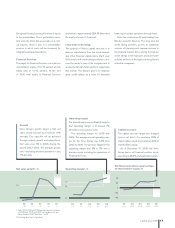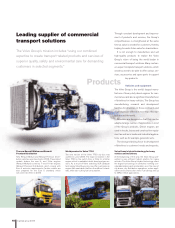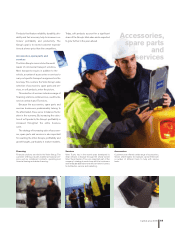Volvo 2006 Annual Report Download - page 14
Download and view the complete annual report
Please find page 14 of the 2006 Volvo annual report below. You can navigate through the pages in the report by either clicking on the pages listed below, or by using the keyword search tool below to find specific information within the annual report.
CEO comment
2006 was an exam year for our strategy. A new generation of
products would be on the market, developed and produced in a
new industrial structure. The new engines would have to meet
the dramatically more stringent emission standards in Europe, the
US and Japan. As we had anticipated, it was an industrious year
– and a great success. 2006 was a record year.
Challenging assignment
>>> Already at the acquistion of Renault Trucks
and Mack six years ago, we knew that the road
ahead was going to be challenging. We faced
the integration of thousands of employees into
new units, changing from three different pro-
duction systems for engines to one common
system, shrinking the engine families from 18
to two and coordinating the truck companies’
purchasing, product planning and product
development in a new unit. In addition, the units
for IT, logistics and spare parts were assigned
to take a Group-wide lead for coordination
within their areas. All these actions were aimed
at gaining maximum benefit from the technical
resources and our combined volumes.
We also had aggressive plans to strengthen
and expand the dealer network to provide bet-
ter service to customers and advance our pos-
itions on new markets.
New and more efficient structure
Accordingly, there were many reasons for con-
cern at the beginning of 2006. We had never
previously implemented such a comprehensive
product renewal. We phased in new production
systems at the same time as we phased out the
old. This was in a booming business climate,
with plants operating at peak capacity.
Concurrently, we put time and resources into
the investments in Asia and Eastern Europe.
Naturally, we are very proud that we suc-
ceeded in realizing our plans. In all significant
respects, we carried out the changeovers as
scheduled and although they increased costs
temporarily our new products rolled out in a
proper manner. The Group is now well consoli-
dated and our own as well as independent deal-
ers have a highly positive development.
Successful products
The solid order bookings at the end of 2006
and beginning of 2007 demonstrate the
strength of the new product generation. The
diesel engines are leading in fuel efficiency
and provide competitive advantages for all of
the Group’s vehicles and equipment. As a result
of the more efficient structure, we have been
able to free up resources to develop more
customer-adapted variants, which further
strengthen positions. As a result of the
increased benefits for the customer, we have
been able to price our vehicles, equipment and
services at the right levels.
Group-wide production
The changes implemented are not solely sig-
nificant structurally, but also important for the
internal transfer of know-how. Increased coor-
dination and common technical solutions have
resulted in improved quality. Step by step we
are developing a Group-wide production
method based on standardization, best prac-
tice and a common corporate culture.
Raised financial targets
Since the changes yield effects in the form of a
structurally higher profitability, the Board
decided to raise the Group’s financial targets.
We are now aiming at an average operating
margin of more than 7 percent over a business
cycle, adding also another, currently, one per-
centage point from the financing operations.
The growth target of 10 percent annually is
retained.
Aggressive strategy for growth
The strategy to reach the growth target is to
grow geographically and at the same time
broaden our offering to customers. We expect
organic growth of 5–6 percent and to obtain
the remaining percent through acquisitions. In
line with this, the Board has sought a distinct
balance between the need for financial free-
dom of action for long-term value growth and
an attractive level for annual share dividends.
Geographically, we are targeting the fast-
growing economies in Eastern Europe and Asia.
The economies in Eastern Europe are in a
very dynamic phase and new transport patterns
are being established. For many years we have
been active in this region extending the dealer
network and services. This is now bearing fruit.
The nearly 40 percent sales increase during
2006 is evidence that we are taking a share of
the rapid economic growth.
Major potential in Asia
Since the quality and emissions standards in
countries such as China and India are still rela-
tively low, the challenge in these countries is
greater. Pricing is different and local manufac-
turing is a necessity for competing with domes-
tic producers. However, in the long term we see
the greatest potential for growth in Asia.
A favorable sign for the environment and our
development is China’s ambition to establish
more stringent emission standards.
In general, we foresee an increasing global
harmonization of technical as well as environ-
mental demands, which strengthens our pos-
ition since we have gone further than the com-
petition in developing a global product program.
10 A global group 2006


